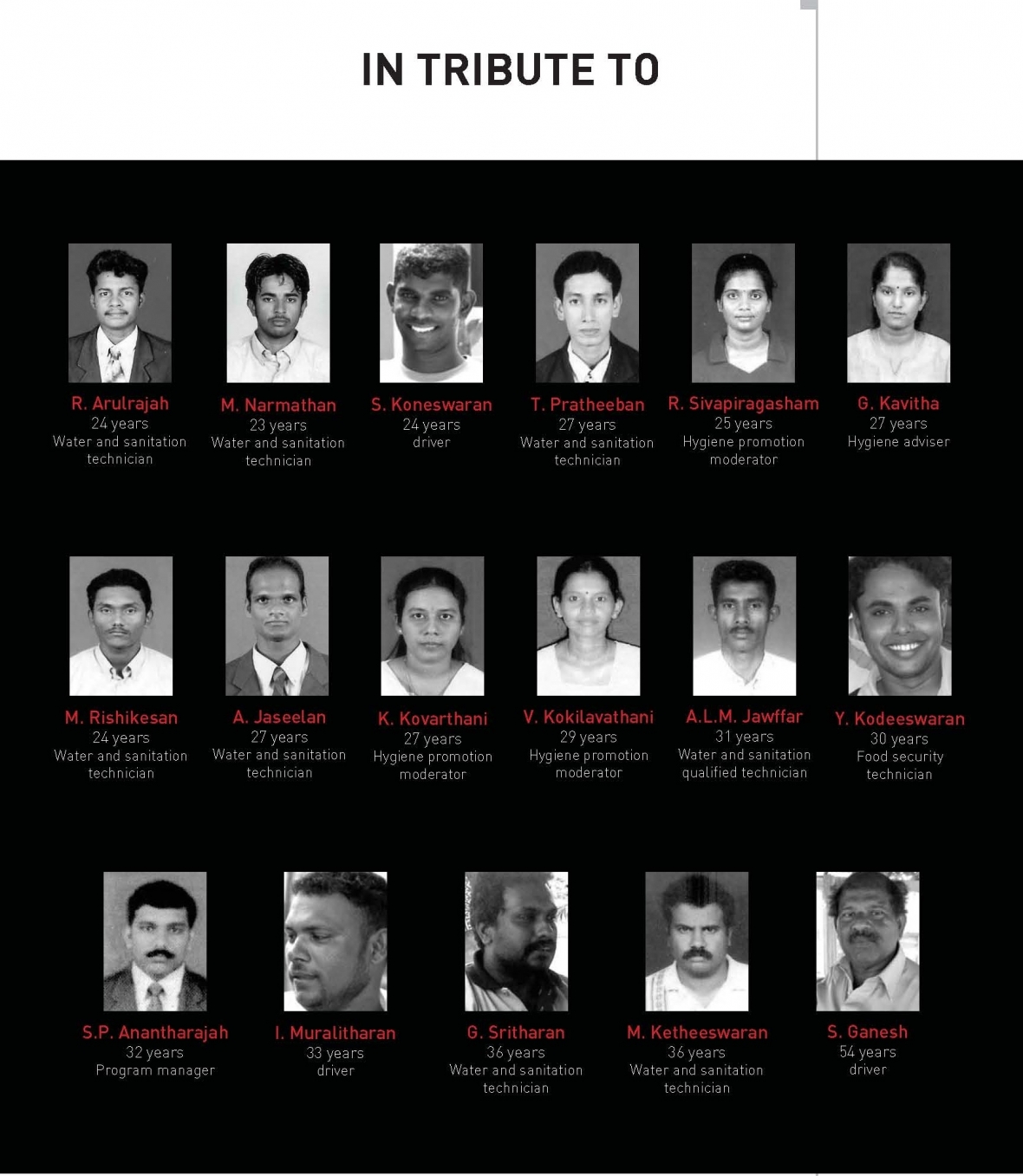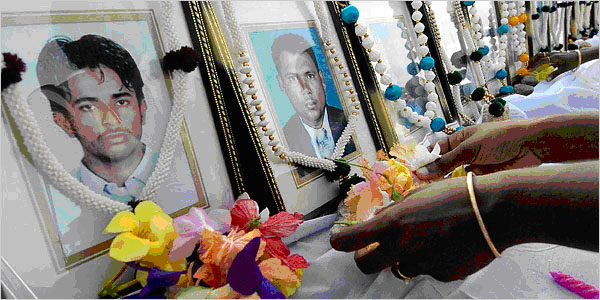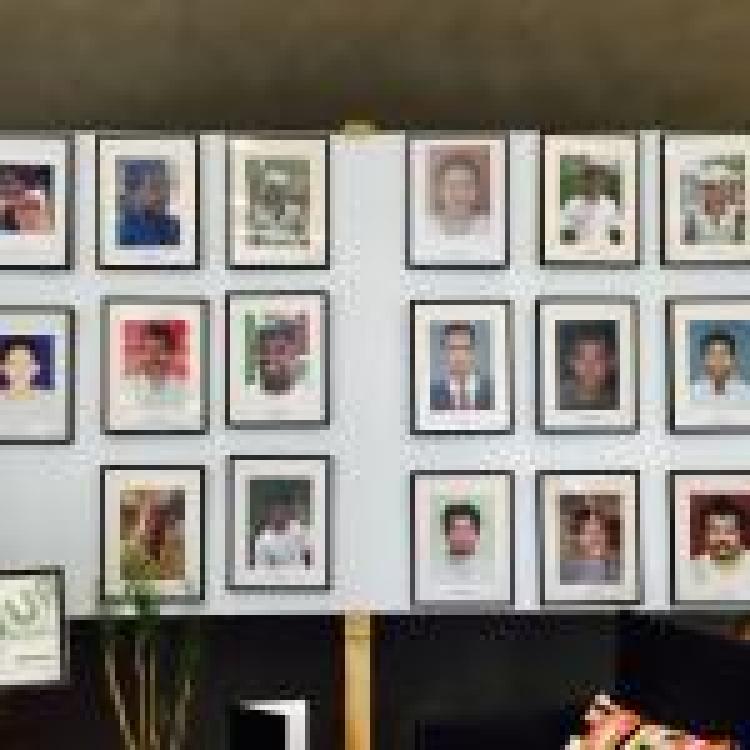
Image courtesy of Action Contre la Faim (ACF)
On this day 15 years ago, Sri Lankan security forces summarily executed 17 aid workers from the French NGO, Action la Contre Faim (ACF), in Muttur, Trincomalee.
The killings, which have since been dubbed as the 'Muttur massacre', took place at the organisation's compund where the ACF team were based as they provided humanitarian assistance to the survivors of the catastrophic tsunami in 2004.
The bodies of 15 aid workers were found lying face down with bullet wounds to their heads and necks, two days after the massacre. On August 8, two more bodies were found in a nearby car.
Sri Lankan security forces had deliberately targeted the aid workers although they were unarmed and were wearing ACF t-shirts at the time of the killing, clearly identifiying that they were humanitarian workers. All of those slain, except one were Tamil, with the killings thought to have been carried out by Sri Lankan security forces.

Image courtesy of Tamil Nation
ACF published a damning report in 2013 highlighting the role of the Sri Lankan security forces and the state's attempt to cover up the crime.
"This makes the Muttur massacre not only a crime against humanitarian personnel of unseen scale but also one of the gravest war crimes committed during the Sri Lankan internal armed conflict," the organisation stated.
"ACF has decided to publicly say that it believes the 17 aid workers were assassinated by Sri Lankan security forces and the criminals have been protected by Sri Lankan authorities," ACF added.
Speaking to Reuters days after the assassination, relatives of those slain blamed the state forces for the massacre.
“We believe it was the army,” Richard Arulrajah, whose 24 year old son was among those shot dead, said. “On Friday he phoned and said he would be back by Saturday. After that, we heard the military personnel came and shot them,” he told the news agency.
Ponuthurai Yogarajah, the father of one of the aid workers, Y. Kodeeswaran had also lost another son Hemachandran just seven months prior to the massacre, where five Tamil students were summarily executed by Sri Lanka's Special Task Force, whilst they spent an afternoon on the beach in Trincomalee.
“There is no use in living,” Yogarajah told Reuters. “Better to have died before them,” he added.
The Sri Lankan Monitoring Mission, which was set up in 2002 to monitor the ceasefire agreement between the Sri Lankan government and the Liberation Tigers of Tamil Eelam (LTTE), had attempted to enter the town of Muttur on August 5 and 6 but were denied entry by Sri Lanka's security forces on the grounds of lack of safety.
Ulf Henricsson, the head of the SLMM told Reuters:
“They are denying us access to the whole area, so we cannot monitor. There were journalist trips arranged to Muttur last Saturday and Sunday. That was possible, but we had no access. Why? For security reasons? Of course not. There are other reasons.”
"When you're not let in, it's a sign that there's something they want to hide," Henricsson added.
Later that month, Henricsson issued a statement indicating the involvement of Sri Lanka's security forces in the massacre.
"Noting the facts outlined in the SLMM findings there are very strong indications of the involvement of the security forces in the act despite their denial [...] Taking into consideration the fact that the security forces has been present in Muttur at the time of the incident it appears highy unlikely to blame other groups for the killing," Henricsson stated.
Campaign video on the killings by ACF and Avaaz (2012)
The following year, former President Mahinda Rajapaksa established a Presidential Commission of Inquiry, to investigate 16 human rights cases, including the assassination of the 17 ACF workers. After a series of delays, the commission released a report in 2015 which stated that there was insufficient evidence to determine who was responsible for the killings and further exonerated the Sri Lankan army and the navy.
A report by the US embassy concluded that members of Sri Lanka's Special Task Force, and the Muslim Home Guard, were the likely perpetrators.
In a leaked US embassy cable, dated April 2008, then Ambassador Robert O Blake wrote,
"The report is meticulous in its account of available evidence. Its conclusions correspond to a large degree with those of the Eminent Persons and other embassy contacts. The report identifies suspect security forces (police constables, and members of the Muslim Home Guard and Special Task Force) by name. It postulates that in the ACF case, then-Deputy Inspector General of Police Rohan Abeywardene (now in charge of all police operations in Colombo) and Senior Superintendent of Police Kapila Jayasekere (now personal assistant to Deputy Inspector General Mahinda Balasuriya, head of STF) instructed that the aid workers be killed."
The Sri Lankan government rejected accusations by ACF outlined in their 2013 report that the military was responsible for the massacre of 17 aid workers in Muttur.
In a statement, released by the army, the government questioned the motives behind ACF’s report, asking why the organisation had withheld evidence from the government.
"This is another instance of a pattern which has emerged since the end of the conflict where certain organizations level allegations against the GoSL without providing sufficient details to enable an investigation. These accusations are then repeated in several other documents, by different agencies, thereby contributing to forming an opinion which is then propagated, without substantiation.
Marking 15 years since the massacre, ACF issued a statement today, reiterating calls for international justice.
"For 15 years, none of the successive Sri Lankan governments has acted in favor of the victims and their families even if the gravity of this crime has been recognised by the highest international authorities. The involvement of the Sri Lankan authorities, their efforts to block any real investigation, and the passing years make the pursuit of justice for our colleagues even more difficult and complex," the organisation said.
Despite a series of domestic 'investigative' processes over the last 15 years, no one has been held accountable for the massacre.

